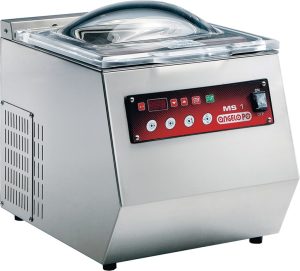professional vacuum machines: Keep Your Food Fresh for Longer
Professional vacuum machines are essential tools for preventing products from spoiling easily and preserving their freshness and aromas.
There is a specific vacuum sealing machine designed to extract the air from a container or special food bag where the food is stored. This technique is useful for preserving both raw and cooked products, whether of animal or plant origin.
Once the food is vacuum sealed, if it is still “fresh,” you can further extend its shelf life by freezing it.

The Benefits of Vacuum Sealing
There are various types of professional vacuum machines available, depending on whether they are intended for professional or domestic use.
Household models have a lower vacuum capacity compared to professional ones. Chamber models, though more expensive, have a higher air extraction capacity, nearly reaching the absolute value of a vacuum.
A pub, bar, or restaurant will undoubtedly need high-quality equipment since these businesses serve food to the public, where product integrity is essential and regulated by stringent standards.
The success of such businesses depends on the quality of the product, making it necessary to always offer fresh foods that are perfectly intact and retain their properties and nutritional values.
This preservation method is also very useful at home, allowing you to make larger grocery purchases without the risk of wasting foods that tend to spoil quickly.
The vacuum sealer ensures long-lasting freshness and genuineness for all types of food and is particularly useful for perishable items like meat and fish.
Storing products in vacuum-sealed packaging offers several advantages for both restaurants and home use, including:
- It maintains the product’s freshness for a longer period.
- It reduces food waste.
- It optimizes space in the refrigerator or freezer.
Investing in a vacuum sealer, whether for professional or home use, is a wise decision. Not only are they affordably priced, but they also help save money in the medium to long term on food purchases.
How Do Professional Vacuum Machines Work?
A freezer alone is not sufficient if you want to maintain freshness and quality for a long time because freezing times are relatively slow, and during this period, the food begins to develop some bacteria resistant to low temperatures. For this reason, vacuum sealing is often combined with the use of a blast chiller, which freezes the product as quickly as possible.
On the other hand, vacuum sealing completely removes air, thereby eliminating oxygen, which is responsible for the formation and proliferation of aerobic bacteria. However, there are some types of bacteria, called anaerobes, that can survive even in the absence of oxygen.
To address this issue, a helpful tip is to pre-treat the food to achieve pasteurization using the sous-vide cooking method.
The vacuum sealing machine is the tool used to remove oxygen from the bag or container where the food product is stored.
For professional use, such as in a pub or restaurant, it is advisable to consider more powerful models capable of creating a perfect vacuum. When choosing the most suitable model for either professional or home use, you should consider the following parameters:
- The vacuum level (measured in mbar) should be as close to zero as possible. This result can only be achieved with highly professional vacuum machines, like chamber models, while domestic ones are unlikely to reach the indicated vacuum level.
- The higher the machine’s suction capacity, the lower the vacuum level will be.
What Foods Can Be Vacuum Sealed and For How Long?
This method allows you to preserve almost all types of food, including:
- Fruits and vegetables
- Meat and fish
- Pasta and bread
- Cold cuts and cheeses
Each of these foods naturally has different shelf lives. Let’s take a closer look.
-
Fruits and Vegetables
Except for particularly juicy fruits like watermelon, melon, persimmons, etc., which cannot undergo vacuum sealing, fruits and vegetables can be easily preserved using this system. Before storing them, it is necessary to wash and thoroughly dry the products. The shelf life of vacuum-sealed fruits and vegetables varies depending on the type, but generally, they can last around 10-15 days.
-
Meat and Fish
These foods are particularly perishable, so their shelf life is shorter. Fish, in particular, tends to spoil more quickly, so it can be preserved for a slightly shorter time than meat. Vacuum-sealed meat lasts about 6-8 days, while fish lasts 4-6 days.
-
Fresh Pasta and Bread
Fresh pasta typically lasts about 4-5 days. The shelf life is significantly extended when the product is vacuum-sealed, reaching up to about 15-20 days. For bread, the shelf life is reduced to a maximum of 6-8 days.
-
Cold Cuts and Cheeses
Here, it is important to distinguish between fresh and aged products. Cold cuts, once sliced, tend to spoil more quickly than whole forms. In both cases, however, vacuum sealing can be used to keep them fresh for longer. Fresh cheeses last about 15 days when vacuum-sealed, while aged cheeses perfectly preserved using the same method can last up to 6 months. The same applies to aged cold cuts, which have the same shelf life as aged cheeses. Sliced meats, on the other hand, have a reduced shelf life of about 15-20 days.
Inert Gas
Some vacuum sealing machines also allow the introduction of an inert gas, which does not interact with the product being preserved, into the bag or container. The inert gas keeps the bag inflated to prevent it from shrinking around the product and potentially damaging it.
To find out which are the best vacuum sealing machines, contact Cook-In, a leader in the sale of professional equipment and machinery for bars, restaurants, and large hotel structures. Contact us for a consultation.



